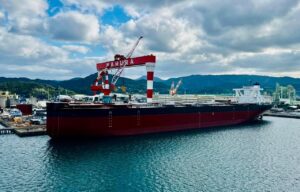
Nasdaq-listed Seanergy Maritime Holdings reported second quarter and first half 2025 financial results, showing a return to profitability with net income of $2.9m despite market volatility. The company generated net revenues of $37.5m, down from $43.1m in Q2 2024, and achieved an Adjusted EBITDA of $18.3m.
The company’s fleet of 21 vessels (2 newcastlemax and 19 capesize) achieved a daily Time Charter Equivalent of $19,807, outperforming the Baltic Capesize Index by around 6%.
For Q3 2025, Seanergy has already fixed about 62% of its days at a rate of $22,375, with a projected total fleet TCE of $23,081.
Seven vessels will earn an average fixed rate of about $22,400 for the second half of 2025.
“Despite a volatile start to 2025, Seanergy returned to profitability in the second quarter, thanks to a stronger capesize market and our strategic hedging activities. With a fleet of 21 capesize vessels and a modest loan to-value ratio of approximately 50%, we are well-positioned to capitalize on favorable market fundamentals,” explained the chief of the company Stamatis Tsantanis.
Concerning the company’s financing activities, Seanergy has completed $110.6m total financings and refinancings year-to-date, including a $22.5m sale and leaseback transaction for the capesize Blueship.
As it is reported, the shipowner is in the process of finalizing the $22.5m sale and leaseback agreement for the 178,459-dwt Blueship (2011-built) with an affiliate of Kowa Kaiun to finance the purchase obligation of the vessel under her existing bareboat charter.
The agreement will become effective upon the delivery of the Blueship to the lessor which is expected around August 25. The company will sell and charter back the vessel on a bareboat basis for a five-year period and will have continuous options to repurchase the vessel at any time following the second anniversary of the delivery at predetermined prices as set forth in the agreement.
CEO and chairman Stamatis Tsantanis highlighted a significant rebound in the capesize market, stating, “The capesize market showed meaningful improvement in the second quarter of the year, with the Baltic Capesize Index averaging approximately $18,700 per day, up from about $13,000 in the first quarter. This was driven mainly by a 16% rise in combined iron ore exports from Australia and Brazil, following the seasonally weak first quarter.”
He also emphasized that the capesize orderbook remains at “historically low levels” at around 8% of the existing fleet, while approximately 7% of the fleet is 20 years or older. “With tightening environmental regulations rendering older tonnage less competitive, we expect net fleet growth to remain modest in the coming years,” the CEO said.



